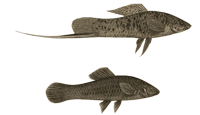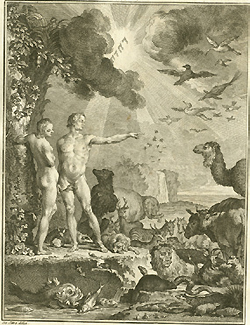

Adam naming the animals, Jacques Christophe Valmont-Bomare, Dictionnaire raisonné universel d’ histoire naturelle, 1775
Origins of the Origin
Evolution Before Darwin
What does a science of change look like? Traditionally, to know something means to consider it as unchanging, separated it from the confusion and complexity of its surroundings, so that knowledge of what it is can emerge. Something that changes is imperfect and hence unknowable.
Ancient science didn’t consider change. Aside from the growth of embryos and juveniles to adults—the “unformed” becoming the “formed“—the ancient science of life focused on classifying species according to clear characteristics and then ranking those species in a great scale: from primitive to advanced, from plants, through worms, insects, fish, reptiles, birds, and mammals, to the human species. Species were ordered according to a progression of perfection: from creatures that only showed simple growth, to ones that displayed reactivity, then mobility, and finally rationality. Species were fixed in their own characteristics and in their place in relation to others. And science could not be imagined any other way.
This was Aristotle’s science, and it cast a long shadow. Two thousand years afterward, Carolus Linnaeus (1707-1778), the Swedish taxonomist, made this science more precise and ordered, but not substantially different. By the late eighteenth century, though, new awareness of fossil life challenged this system. At first, fossil plants and animals could be accommodated within it—and even assigned to existing classes and phyla. But fundamentally troubling was the fact that some species no longer existed, and that many current species were not in the fossil record. The fossil world began to assume a shape of its own. William Smith (1769-1839), an English surveyor and geologist, could correlate rock strata far removed from one another by the fossils they contained.
By 1800, Georges Cuvier (1769-1832), a French zoologist, had provided one way to deal with this new world: instead of one system of the living world, he proposed several such systems, each of its own time, one after another. Thus the earliest fossils witnessed to an age of invertebrates, replaced by the age of fishes, the age of reptiles, the age of mammals, and finally the age of humans.
Last Reviewed: May 7, 2014


